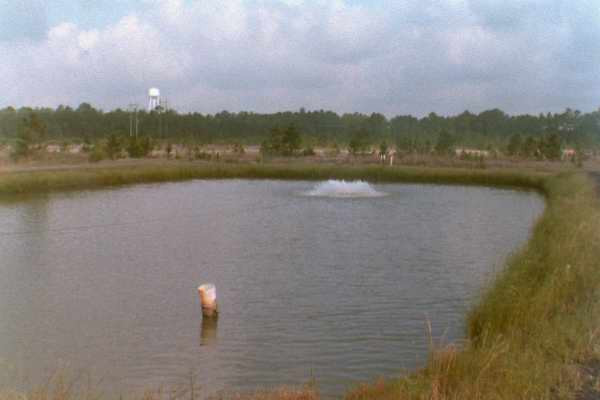The MSU-Coastal Research and Extension Center in collaboration with the MSU-Department of Wildlife and Fisheries and the MSU-Aquaculture Research Unit conducted an experiment using vertical artificial substrates in pond culture of freshwater prawns in quarter-acre ponds at the MSU-Coastal Aquaculture Unit.  Eight 1/4-acre ponds were used in the experiment starting on June 26, 1999. Artificial substrates covering an area equivalent to 100% of the bottom area were installed in each of four treatment ponds. These substrates which were made of 4 ft x 100 ft orange construction fencing were installed across the length of the pond.
Eight 1/4-acre ponds were used in the experiment starting on June 26, 1999. Artificial substrates covering an area equivalent to 100% of the bottom area were installed in each of four treatment ponds. These substrates which were made of 4 ft x 100 ft orange construction fencing were installed across the length of the pond.
Each 1/4-acre pond was stocked with 5,000 45-day-old postlarvae weighing about 0.245 g each and harvested after 120 culture days. Slow sinking shrimp feed with 32% protein was broadcast along four sides of each pond two times daily. The feeding schedule was computer generated by the staff of the MSU-Department of Fisheries and Wildlife (DFW). Dissolved oxygen and temperature were monitored twice each day while salinity, pH, total ammonia, nitrogen, and nitrite were measured on a biweekly basis. All of the ponds used in the experiments were equipped with 1-hp electric aerators.
Freshwater prawn harvest results showed that the use of vertical substrates did not improve freshwater prawn yield, survival rate, and harvest size. Prawn yields averaged 1200 and 1196 lb/acre for ponds with and without substrates, respectively. Ponds with substrates had similar average survival rate (71%) and prawn count (12 per lb) with those ponds without artificial substrates (73%, 12 per lb). A lower feed conversion ratio was reported in ponds with 100% added substrates (3.30 vs. 3.17).
